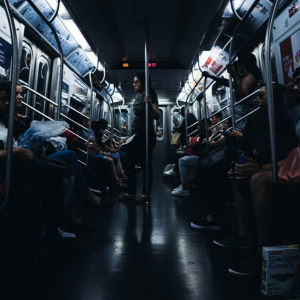Eight Myths about Harassment while Travelling: What to Do if you Experience It, and What to Do if you See Someone Else being Harassed
Dr Sophie Harwood, our Women Traveller Advisor, was recently harassed during a daytime train journey across Germany, which prompted her to investigate instances of women being harassed during travel from which she discovered that there are several why, when, who by and how myths. This article debunks these myths and offers advice on appropriate action, including help bystanders can offer.
A few weeks ago I was travelling alone on the train from Hanover to Berlin. It was early evening and I had my dog with me. I took my seat by the window, put on my headphones, and opened my book. A short while later, a man sat in the aisle-seat opposite me. He tried to talk to me but I couldn’t hear as I had my headphones on. However, my dog started growling, which alerted me to what was happening. I took my headphones off to see what he wanted, which turned out to be just to engage me in conversation. I answered a few questions politely, if not particularly enthusiastically, and then indicated that I was going back to my book.
He tried to move into the seat next to me, at which point my dog switched from growling to barking. The man sat back down in his seat. He then decided that teasing my dog was another way to get my attention: he started growling and barking at my dog to provoke a reaction. I asked him to stop several times: “please, stop”. He continued. He then started growling, barking and gnashing his teeth directly at me.
 A few rows in front of me were three businessmen; they looked as though they could help and I hoped one might get up as they could clearly hear what was going on, but they remained glued to their laptops. Eventually, a woman a few rows behind me stood up and cleared her throat. The growling man became polite and asked if he was disturbing her. She said she was sensitive to noise, at which point he said that he would just leave because he was “tired of this girl and her sh*t dog anyway”. After he had gone one of the businessmen came over and asked if I was okay, it was too little too late.
A few rows in front of me were three businessmen; they looked as though they could help and I hoped one might get up as they could clearly hear what was going on, but they remained glued to their laptops. Eventually, a woman a few rows behind me stood up and cleared her throat. The growling man became polite and asked if he was disturbing her. She said she was sensitive to noise, at which point he said that he would just leave because he was “tired of this girl and her sh*t dog anyway”. After he had gone one of the businessmen came over and asked if I was okay, it was too little too late.
Having worked in the travel risk world for so many years I was still thinking about this situation that next day along four main strands:
To try and understand the wider picture I opened a thread on Twitter and invited people to share their experiences of harassment while travelling. I was surprised with both the number of responses I received and also the speed that the stories came in. After reading them all, as well as reading the responses from men reacting to these stories, it became clear that there are certain “myths” about harassment while travelling.
These myths go against our accepted narrative and are why some people are shocked, surprised or even disbelieving when they hear such stories. In addition, women are often unprepared with how to deal with these events, because we’re rarely told or taught how to react (because the accepted narrative tells us that such occurrences are so rare or exceptional that it’s not essential).
Similarly, we don’t always know what to do when we see someone else being harassed: perhaps we’re afraid that the attention will then be turned on us, or we’ll escalate the situation, or we’re misreading the situation in the first place, or that someone else bigger and stronger is better placed to intervene.
So, this article tries to do three things:
1. to bust some common myths about harassment while travelling.
2. to offer some advice on what women can do if we experience harassment.
3. to offer some advice on what you can do if you see someone being harassed.
Eight Myths about Harassment when Travelling
1. You’ll only be harassed if you travel alone, at night, or while wearing “revealing” clothes
While it’s true that you’re more likely to be harassed if you’re alone, this does not mean that travelling with someone will always deter harassers. An academic at Oxford University was travelling on a train with a male companion, but was still called “f*cking ugly” and a “c*nt” by another man after she refused to respond to his “give us a smile” demand. A Scottish woman told me that as a teenager, her and a friend were flashed on a bus by an older man who exposed his erect penis to them. In this case, the fact that there were two of them may actually have been an added incentive in choosing them to harass.
 Similarly, most of the harassment I have experienced or stories I have heard about harassment while travelling has happened in broad daylight or the early evening. It’s true that a lot of “opportunistic” harassment may occur at night, when the perpetrators are perhaps more likely to have their confidence enhanced by alcohol or other substances, but habitual harassers are just as likely to operate during the day.
Similarly, most of the harassment I have experienced or stories I have heard about harassment while travelling has happened in broad daylight or the early evening. It’s true that a lot of “opportunistic” harassment may occur at night, when the perpetrators are perhaps more likely to have their confidence enhanced by alcohol or other substances, but habitual harassers are just as likely to operate during the day.
And, while it may be true that women in revealing clothes are harassed, so too are women wearing woollen coats, jeans, turtleneck sweaters, or suits. In fact, the recent “What Were You Wearing?” exhibition at the Molenbeek Maritime Community Centre in Brussels used testimonies from rape-survivors to recreate the outfits they were wearing at the time of their attacks to highlight that clothing is not a causal factor when it comes to harassment or assault.
Another ugly side to this myth is that it is sometimes used as a way to victim-blame or to suggest that women are complicit in their own harassment.
2. Potential harassers are “easy to spot” and therefore easy to avoid
As with almost anything, it’s not possible to judge someone on their appearance and therefore there is no identikit profile of a likely harasser. While the media likes to paint a picture of harassers being ill-dressed or drunken, anecdotal evidence suggests otherwise. A lecturer at Hull University told me she was groped by a young man in a well-tailored suit on the London Underground. A student at York University told me about a middle-aged man in a well-tailored suit who sat opposite her on the London Underground and started to masturbate while he stared at her legs. An Houses of Parliament employee once told me that I was pretty but needed “a shorter skirt and bigger boobs”.
As the fallout from the Harvey Weinstein revelations continues, alongside the #TimesUp and #MeToo campaigns, the fact that harassers and assailants can just as easily be well-dressed, well-educated and apparently sophisticated men is gaining more and more acknowledgement.
3. Harassers won’t harass if they’re in a crowded space or there are likely to be witnesses
 For some perpetrators the fact that there could be witnesses is part of the thrill of harassment. Similarly, a crowded space may actually provide them with the opportunity to conduct harassment and even assault. It can even provide a defence if they’re caught or challenged, as they can claim they had “no choice” but to be that close, or that it wasn’t them but someone else nearby. Numerous women told me about having their breasts or buttocks groped while on crowded trains, busses, or other transport systems. A lecturer at Leeds University recounted how a man was masturbating in a crowded Paris metro carriage but that it went undetected until she and two other women realised they had ejaculate on their clothing; the police officer that they reported it to was unsurprised by their story.
For some perpetrators the fact that there could be witnesses is part of the thrill of harassment. Similarly, a crowded space may actually provide them with the opportunity to conduct harassment and even assault. It can even provide a defence if they’re caught or challenged, as they can claim they had “no choice” but to be that close, or that it wasn’t them but someone else nearby. Numerous women told me about having their breasts or buttocks groped while on crowded trains, busses, or other transport systems. A lecturer at Leeds University recounted how a man was masturbating in a crowded Paris metro carriage but that it went undetected until she and two other women realised they had ejaculate on their clothing; the police officer that they reported it to was unsurprised by their story.
When Transport for London launched their “Report It to Stop It” campaign in 2017 against sexual harassment on public transport, the advertising specifically featured the harassment experienced by women on crowded tube carriages as it is such a common site for harassment.
4. Harassment is rarely a problem in economically-developed cities and regions
Another common myth is that harassment is not something that happens in locations that apparently have “good” records for women’s rights and equality, crime figures, and general health and safety standards. But the surface only needs to be scratched to bust this myth. As already mentioned above, Transport for London had to launch a campaign against harassment because of the intensity of the problem.
In France, 220,000 women reported sexual harassment on public transport in the past two years, and Paris recently implemented new safety measures (such as additional plain-clothes officers and surveillance cameras) to try to improve the notoriously dire situation on the Metro system. Melbourne also launched an anti-harassment campaign called “Hands Off” due to the frequency of problems on their public transport network. Almost all the stories that were sent to me were incidents that took place in the UK, USA, or Europe. When it comes to harassment, it seems that there are no “low risk” regions.
5. Harassment won’t happen in “private” transport such as taxis or pre-booked cars
Women are often advised to take taxis or pre-booked cars as a “safer” alternative to public transport, despite the added cost (which means they are not even an option to begin with for some women). However, while it’s true that they are statistically safer, they are by no means a guarantee of safety. A researcher at the University of Delaware told me she had to stop using services such as Uber and Lyft because of the number of times she was harassed by their drivers.
Currently there is a controversy in the UK as the so-called Black Cab Rapist, John Warboys, was due for release from prison after less than ten years despite being convicted of nineteen serious sexual assaults against female passengers of his taxi (and being suspected of at least a hundred more), making him Britain’s most prolific sex offender. Precautions still therefore need to be taken even when using taxis or pre-booked cars.
6. Harassment won’t happen during “high end” travel such as air travel
While harassment on the street, on busses, on metro networks or even taxis seems to be relatively prolific, the issue of harassment on aeroplanes is an area that has not yet been fully explored to the same extent. The levels of security and scrutiny that air passengers have to go through means that we might anticipate only “safe and secure” people are permitted to fly. However, while they may pose no threat to the aircraft or possess any weapons, there is no way to screen for their potential to conduct harassment (as in Myth 2, there is no way to spot a harasser).
 A researcher at Leeds University told me about a long-haul flight she was on from the UK to Australia during which the man sitting next to her continually stroked her leg, attempted to grope her breasts, and told her stories about his sexual exploits. She was nervous about escalating the situation by doing anything, but eventually one of the cabin crew noticed and when she went to the bathroom they stepped in and removed him from that row of seating. Another researcher at the University of Delaware also experienced unwanted sexual behaviour from a fellow passenger when a young man next to her on a flight from Chicago to Los Angeles masturbated twice through his sweatpants. This was a crowded flight that also included families and children in the row opposite them. Again, she was nervous to say anything to the cabin crew in-case it escalated the situation, or indeed if getting the attention was part of his thrill, and so she tried to ignore it.
A researcher at Leeds University told me about a long-haul flight she was on from the UK to Australia during which the man sitting next to her continually stroked her leg, attempted to grope her breasts, and told her stories about his sexual exploits. She was nervous about escalating the situation by doing anything, but eventually one of the cabin crew noticed and when she went to the bathroom they stepped in and removed him from that row of seating. Another researcher at the University of Delaware also experienced unwanted sexual behaviour from a fellow passenger when a young man next to her on a flight from Chicago to Los Angeles masturbated twice through his sweatpants. This was a crowded flight that also included families and children in the row opposite them. Again, she was nervous to say anything to the cabin crew in-case it escalated the situation, or indeed if getting the attention was part of his thrill, and so she tried to ignore it.
The nature of air travel, where options may be severely limited in terms of where or how you can move in the cabin or indeed leave the aircraft, means that women are potentially even more “captive” when it comes to harassment than on the ground.
7. Harassment is always sexually motivated
The majority of this article and anecdotes so far have been about sexual harassment. However, sexual thrill or gratification may not be the only motivation. As with the story I recounted at the beginning of this article, sometimes harassment may be purely about enjoying power or dominance over another person. Harassers may get their thrill out of seeing someone afraid or upset. Many women feel that if there hasn’t been an obvious sexual element to the harassment that they’ve experienced then it “doesn’t count”. However, any situation in which a person’s safety or security is threatened is considered as harassment.
8. Harassment is upsetting, but (unlike assault) it isn’t actually illegal
Sexual harassment can have a broad definition, and as such, the legalities can be problematic to pinpoint and many people are therefore reluctant to make reports. However, there are specific instances of harassment that do conform to more easily-defined legal codes, and can be prosecuted. For example, being followed to or from your home or work, having unwanted personal photographs taken of you, or being subject to unwanted advances and persistent or distressing comments can be prosecuted under the Protection from Harassment Act 1997, and unwanted touching by someone who gets sexual gratification from that touching (for example, on public transport) can be prosecuted under the Sexual Offences Act (both refer to UK statutes).
Another University researcher was once ‘upskirted’ (when a person secretly takes photographs under someone’s skirt) by a man behind her on an escalator on the tube in London; she was unaware of what was happening, but another commuter noticed, made her aware, and reported the man to the London Transport Police. He was held, and his camera showed evidence of upskirt photographs of numerous other women. He was later prosecuted and pleaded guilty.
What can be done?
Having reviewed the myths, many of which contradict the traditional advice for women on how to avoid harassment, what advice is worth following? Unfortunately there is no one-size-fits-all solution; the problem is so prevalent and varied, both by method of harassment and where it happens, combined with the fact that all women have different capabilities, risk profiles and experience to deal with any given situation. There is some generic advice we can suggest, however, it must be used judiciously as it will only be appropriate for certain women, at certain times, in certain places, and only in certain circumstances.
First of all, we should consider how to mitigate the risk of encountering harassment when travelling, these won’t always guarantee a harassment-free journey, but they should help:
 Unfortunately, even if women follow as many mitigation strategies as possible, they can still be subject to harassment. Here are some potential strategies for dealing with that harassment if and when it occurs:
Unfortunately, even if women follow as many mitigation strategies as possible, they can still be subject to harassment. Here are some potential strategies for dealing with that harassment if and when it occurs:
Finally, what can you do if you think you see someone being subjected to harassment? There is no overarching advice for all situations, but here are a few options that could be considered:
- – Pretend you know the person being harassed and approach them to physically get between them and their harasser: “Oh hi! It’s been ages! So sorry to interrupt but I wanted to see how you are?”. [Note that this approach is often better for women who are looking to intervene, as men following this strategy may just appear to be yet another harasser looking to latch onto the woman in question].
- – Pretend that the person being harassed is sitting in your seat (this mainly works for trains) and ask them politely to move.
- – Invent a way to move the person being harassed out of the situation: for example, give the appearance of a member of staff and tell them that they have received an urgent phone-call at the hotel’s bar or that the table at which they are sitting is reserved and they need to move elsewhere, then accompany them to somewhere they feel safe (ensuring that the harasser does not follow).
The harassment of women when travelling is so commonplace that almost every woman has at least one story to tell, with many examples that border on assault. In the climate of #MeToo and #TimesUp, it’s time to make sure that the spotlight is also being shone onto safety in our transport networks. The problem need to be addressed, and in the meantime, women need to be informed and empowered as to how to mitigate the risk of harassment and their options of responding to it should (when) it occur. Equally, men and women need to know their options of how to respond should they see it happening to someone else. As there are more non-harassers than harassers; we must be able to win this one.
Click here to understand how you can better prepare your employees for safe travel and ensure you are fulfilling your duty of care requirements. If you would like to contact beTravelwise and share your experience please email us at hello@betravelwise.com
8th March 2018